- Главная
- Разное
- Дизайн
- Бизнес и предпринимательство
- Аналитика
- Образование
- Развлечения
- Красота и здоровье
- Финансы
- Государство
- Путешествия
- Спорт
- Недвижимость
- Армия
- Графика
- Культурология
- Еда и кулинария
- Лингвистика
- Английский язык
- Астрономия
- Алгебра
- Биология
- География
- Детские презентации
- Информатика
- История
- Литература
- Маркетинг
- Математика
- Медицина
- Менеджмент
- Музыка
- МХК
- Немецкий язык
- ОБЖ
- Обществознание
- Окружающий мир
- Педагогика
- Русский язык
- Технология
- Физика
- Философия
- Химия
- Шаблоны, картинки для презентаций
- Экология
- Экономика
- Юриспруденция
Epoxy-Based Fibre Reinforced Nanocomposites презентация
Содержание
- 1. Epoxy-Based Fibre Reinforced Nanocomposites
- 2. Plan 1) Useful phrases and keywords 2)
- 3. Useful phrases and keywords Fibre-reinforced epoxy
- 4. The modification of epoxy resins In the
- 5. Introduction Epoxy resins are widely used in
- 6. Properties of epoxy resins The development of
- 7. A newly developed approach offering promising results
- 9. Concluding remarks Fibre-reinforced composites are a type
- 10. List of sources used [1] J. Kong,
- 11. THANK YOU FOR ATTENTION !
Слайд 2Plan
1) Useful phrases and keywords
2) The modification of epoxy resins
3) Introduction
4)
Properties of epoxy resins
5) Concluding remarks
6) List of sources used
5) Concluding remarks
6) List of sources used
Слайд 3Useful phrases and keywords
Fibre-reinforced epoxy composites – композиты на основе
эпоксидной смолы
Carbon nanotubes (CNT) – углеродные нанотрубки
Nanofibres - нановолокона
Nanoclay - наноглины
Epoxy resins - эпоксидные смолы
Glass transition temperature (Tg) - температура стеклования
Thermosetting polymers - термореактивные полимеры
Carbon nanotubes (CNT) – углеродные нанотрубки
Nanofibres - нановолокона
Nanoclay - наноглины
Epoxy resins - эпоксидные смолы
Glass transition temperature (Tg) - температура стеклования
Thermosetting polymers - термореактивные полимеры
Слайд 4The modification of epoxy resins
In the article presented, the modification of
epoxy resins with nanoparticles could endow the materials with some superior properties such as broadening of the glass transition temperatures, modest increases in the glassy modulus, low dielectric constant, and significant increases in key mechanical properties.
In the last 15 years, some studies have shown the potential improvement in properties and performances of fibre reinforced polymer matrix materials in which nano and micro-scale particles were incorporated.
In the last 15 years, some studies have shown the potential improvement in properties and performances of fibre reinforced polymer matrix materials in which nano and micro-scale particles were incorporated.
Слайд 5Introduction
Epoxy resins are widely used in fibre-reinforced composites due to their
superior thermal, mechanical, and electrical properties. Depending on the chemical compositions and curing kinetics, it is possible to vary their mechanical properties ranging from extreme flexibility to high strength and hardness, and physical properties such as adhesive strength, chemical resistance, heat resistance and electrical resistance.
The widespread use of the epoxy thermosets, however, is limited in many high-performance applications because of their inherent brittleness, delamination and fracture toughness limitations.
The widespread use of the epoxy thermosets, however, is limited in many high-performance applications because of their inherent brittleness, delamination and fracture toughness limitations.
Слайд 6Properties of epoxy resins
The development of improved high performance composites based
on thermosetting polymers can only be achieved by simultaneously improving resin, fibre and interface properties.
Significant property improvements are currently made possible by using resins, curing agents and co-monomers with new backbone chemistries, which provide networks with reduced moisture absorption, modification of the thermoset resins with thermoplastic polymer, and incorporating tough thermoset or thermoplastic films in the form of interpenetrating network systems.
The most successful strategies concerning the toughening of epoxy resins involve the incorporation of dispersed elastomeric and thermoplastic phases into the resin matrix, which results in a multiphase polymeric system.
Unfortunately, such methods generally do not provide adequate improvements in toughness for highly crosslinked, high glass transition temperature (Tg) epoxies and their composites for e.g. aerospace and automotive applications.
Significant property improvements are currently made possible by using resins, curing agents and co-monomers with new backbone chemistries, which provide networks with reduced moisture absorption, modification of the thermoset resins with thermoplastic polymer, and incorporating tough thermoset or thermoplastic films in the form of interpenetrating network systems.
The most successful strategies concerning the toughening of epoxy resins involve the incorporation of dispersed elastomeric and thermoplastic phases into the resin matrix, which results in a multiphase polymeric system.
Unfortunately, such methods generally do not provide adequate improvements in toughness for highly crosslinked, high glass transition temperature (Tg) epoxies and their composites for e.g. aerospace and automotive applications.
Слайд 7A newly developed approach offering promising results and a unique level
of mechanical properties enhancement and/or control involves the use of nano-sized organic and inorganic particles.
Due to the molecular size of their reinforcement, polymer nanocomposites offer the possibility to develop new materials with unusual properties. Nano-particles are presently considered to be high-potential filler materials for the improvement of mechanical and physical polymer properties. Candidates in the collectivity of nano-particles with a high-potential for the enhancement of mechanical and physical properties of polymers are carbon nanotubes, nanofibres and nanoclays.
Due to the molecular size of their reinforcement, polymer nanocomposites offer the possibility to develop new materials with unusual properties. Nano-particles are presently considered to be high-potential filler materials for the improvement of mechanical and physical polymer properties. Candidates in the collectivity of nano-particles with a high-potential for the enhancement of mechanical and physical properties of polymers are carbon nanotubes, nanofibres and nanoclays.
Слайд 9Concluding remarks
Fibre-reinforced composites are a type of engineering material that has
exhibited high strength–weight and modulus–weight ratios, even compared with some metallic materials.
In the last two decade, some studies have shown the potential improvement in properties and performances of fibre reinforced polymer matrix materials in which nano and micro-scale particles were incorporated.
To date, nanoparticle reinforcement of fibre reinforced composites has been shown to be a possibility, but much work remains to be performed in order to understand how nanoreinforcement results in major changes in material properties. The understanding of these phenomena will facilitate their extension to the reinforcement of more complicated anisotropic structures and advanced polymeric composite systems.
Nanoparticles provide a high potential for the modification of polymers. They are very effective fillers regarding mechanical properties, especially toughness.
In the last two decade, some studies have shown the potential improvement in properties and performances of fibre reinforced polymer matrix materials in which nano and micro-scale particles were incorporated.
To date, nanoparticle reinforcement of fibre reinforced composites has been shown to be a possibility, but much work remains to be performed in order to understand how nanoreinforcement results in major changes in material properties. The understanding of these phenomena will facilitate their extension to the reinforcement of more complicated anisotropic structures and advanced polymeric composite systems.
Nanoparticles provide a high potential for the modification of polymers. They are very effective fillers regarding mechanical properties, especially toughness.
Слайд 10List of sources used
[1] J. Kong, R. Ning, Y. Tang, J.
Mater. Sci. 2006, 41, 1639.
[2] Sritima Kar, A. K. Banthia, J. Appl. Polym. Sci. 2005, 96, 2446.
[3] A. R. Siebert, in: Rubber-Modified Thermoset Resins. Based on a symposium held at the 186th Meeting of the American Chemical Society. Washington, DC, 1984, 179.
[4] Dodiuk, H. Kenig, S. Blinsky, I. Dotan,A., A. Buchman, J. Adhesion and Adhes. 2005, 25, 211
[2] Sritima Kar, A. K. Banthia, J. Appl. Polym. Sci. 2005, 96, 2446.
[3] A. R. Siebert, in: Rubber-Modified Thermoset Resins. Based on a symposium held at the 186th Meeting of the American Chemical Society. Washington, DC, 1984, 179.
[4] Dodiuk, H. Kenig, S. Blinsky, I. Dotan,A., A. Buchman, J. Adhesion and Adhes. 2005, 25, 211
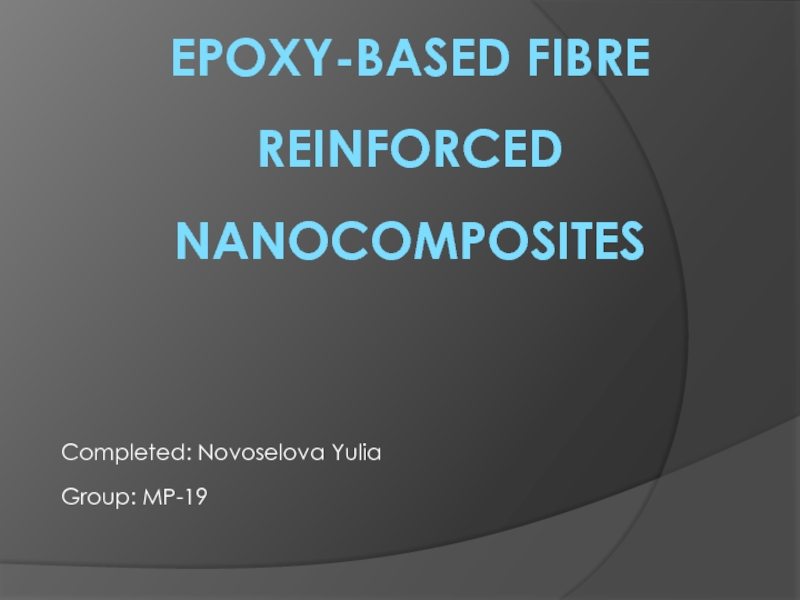


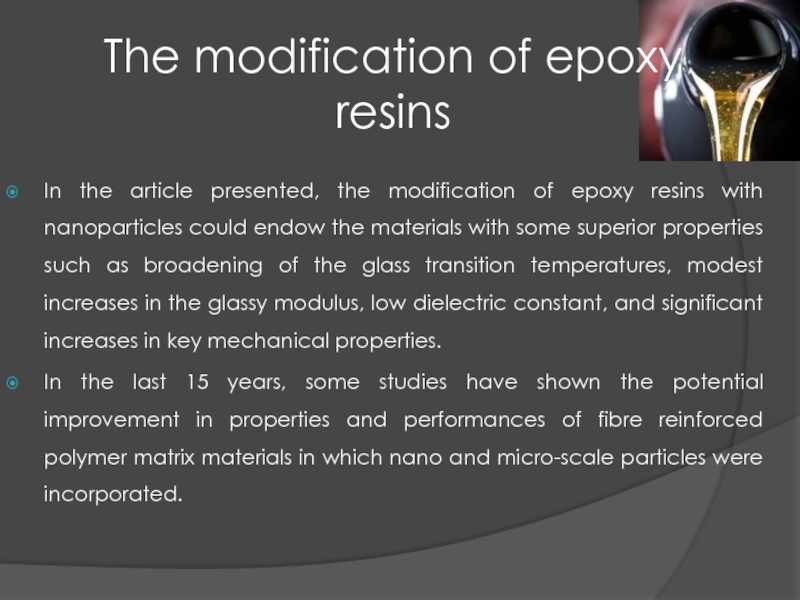
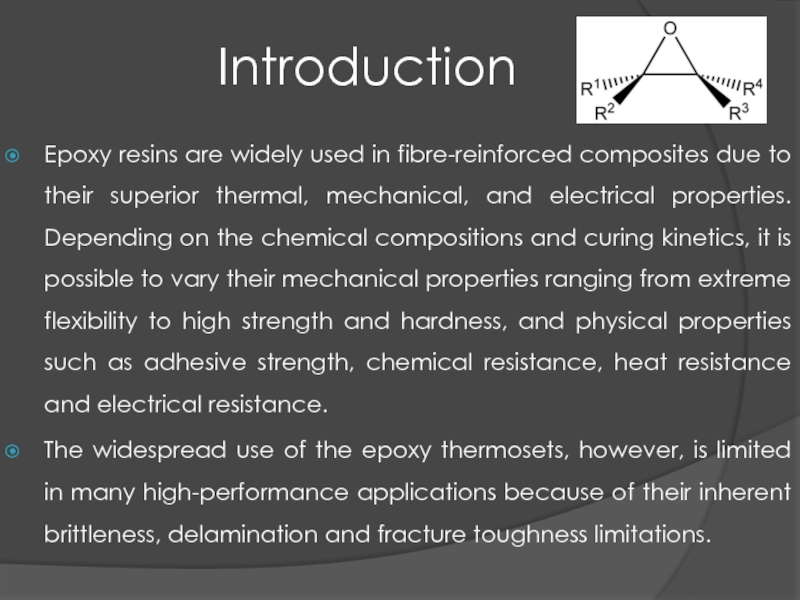

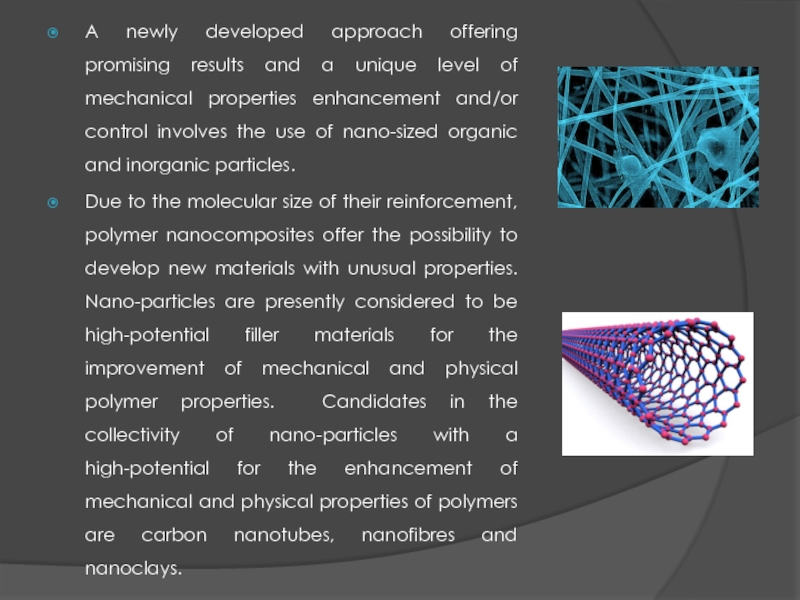
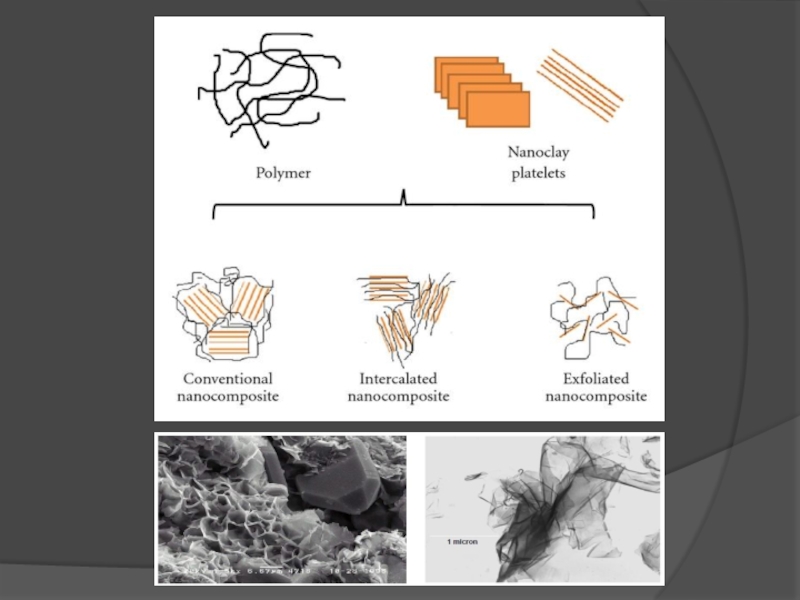
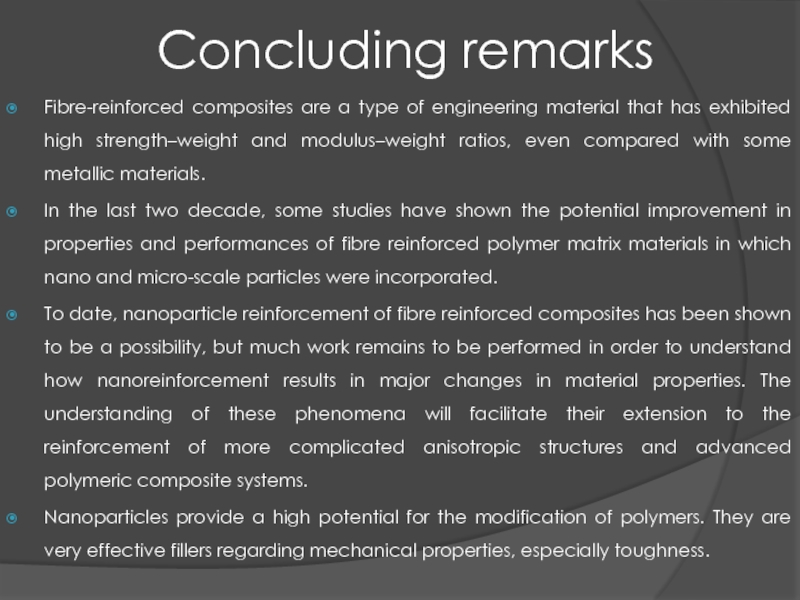
![List of sources used[1] J. Kong, R. Ning, Y. Tang, J. Mater. Sci. 2006, 41,](/img/tmb/1/65738/2a2670db8c11a37c01c63a0db74ea039-800x.jpg)






